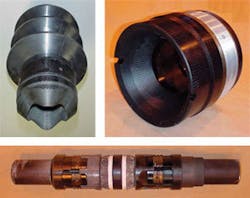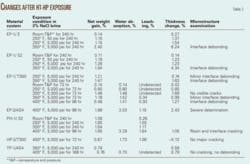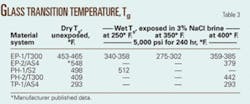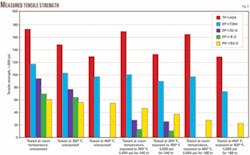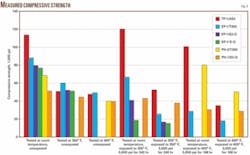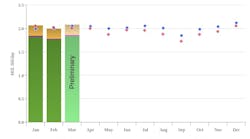Advanced fiber-reinforced polymer composites offer new options for working on and completing deep wells that have high temperatures and pressures (HT-HP) and produce corrosive fluids, although proper material selection requires an understanding of the composite’s hot-wet thermomechanical behavior.
Companies can include composites in drilling, logging, completion, production, and workover. Completions and workovers often require tools set temporarily in a wellbore that need to be made from easily drilled or milled out materials. Offshore deepwater extended-reach drilling and completions require materials for downhole tubular components and equipment that are lightweight and fatigue-resistant.1 2
Advanced fiber reinforced, high-temperature polymer composites can function at elevated temperatures in deep wells while offering advantages such as lightweight, corrosion resistance, long fatigue life, and easy removal. Furthermore, nonconductive and nonmagnetic high-temperature polymer composites are ideal for resistivity and induction logging tools.2
Aerospace and other industrial applications, including oil field operations, have incorporated in various applications such high-temperature polymers as polyimides, cyanate esters, phenolics, high-temperature epoxies, thermoplastics, and their composites.1 2
Under moisture or a wet condition with high-temperature, however, most polymers and their composites behave differently from their original dry state because of severe hydrolytic and hydrothermal degradations from the high-temperature wet environment.3
It is therefore important to understand the HT-HP hot-wet thermomechanical behavior of various high-temperature polymer resins, reinforcement fibers, and their composites.3
Composites downhole
The petroleum industry has actively researched and used composites downhole since the mid-1960s. It has developed numerous fiber-reinforced composite products for downhole operations, such as sucker rods, tubing and casing, drill pipes, coiled tubing, and well screens.1 2 These applications, however, have limited temperature ratings, mostly below 200° F., and lack long-term performance reliability under HT-HP downhole conditions.
Many downhole operations require service tools that perform in a hot-wet fluid at temperatures greater than 400° F. and pressures greater than 10,000 psi. These conditions require more advanced HT-HP hot-wet resistant composite materials.
Sucker rods
Development of fiberglass sucker rod strings for beam-pumped oil wells started in the mid-1970s to meet the demand for downhole corrosion resistance.
These strings had pultruded fiberglass rods with steel connectors at two ends. Pultruded fiberglass rods possess high tensile strength, are lightweight, and have good corrosion resistance.
With proper string design, the fiberglass sucker rods can increase the production rate, reduce energy consumption, and provide longer rod life.
Temperature remains the major limitation for expanding field applications. Most operators install the rods in wells with bottomhole temperatures of less than 180° F.
Tubulars
In the early 1980s, the industry started using CO2 flooding for enhancing oil recovery. Mixing CO2 and water causes severe corrosion to traditional steel tubing strings.
These corrosion problems expanded the use of corrosion resistance and lightweight, glass fiber-reinforced polymer (GRP) pipe to high-pressure downhole and surface applications, including water and gas injection lines, and downhole tubing and casing.
To establish an industrial standard, the American Petroleum Institute (API), in the mid 1980s, initiated the development of pressure-rating methodologies and purchase specification for commercial high-pressure fiberglass line pipe (API 15HR) and downhole tubing (API 15TR).
API, in 1992, only published API 15HR. This specification provides purchase guidelines and pressure-rating methods for high-pressure fiberglass line pipes with internal pressure rating from 500 to 5,000 psi, but the service temperature specified for long-term applications was limited to less than 150° F.
Although several manufacturers sell filament-wound GRP downhole tubing and casing products, no industrial standards or specifications exist today for these products.
The primary industry concerns in using these products are the lack of standards and application data and long-term performance uncertainty.
Composite drill pipe
Horizontal and extended-reach drilling has expanded since the 1980s in both onshore and offshore operations. The heavy weight of conventional steel drill pipe, however, has limited drilling operations.
Lightweight composite materials can reduce the frictional drag of drill pipe on the wellbore. Also carbon fiber-reinforced composite tubular structures are applicable for extended reach and deepwater drilling because of their high torsional stiffness and strength, flexibility, and long fatigue life.
One vendor introduced small-sized flexible composite drill pipe products into the market in the mid-1990s. A major application of this drill pipe is in short-radius lateral drilling.
A program was initiated in 1999 for developing cost-effective, larger sized composite drill pipe for extended-reach and deepwater (ER-DW) drilling. The goal was to attain about a 50% weight saving over steel drill pipe. This would enable ER-DW drilling and real-time data and power transmissions through the drilling string.
Recently, a program developed 6-in. ER-DW composite drill pipe that is now under field evaluation. Because the major reinforcement material in the drill pipe is carbon fiber, and drill pipe is a short-term application, the pipe usually has a temperature rating higher than other downhole fiberglass products.
Drillers, however, commonly use composite drill pipe in holes that have a temperature of less than 250° F.
Spoolable tubing
Although the industry widely uses metallic spoolable tubing in downhole applications, limitations such as heavy weight, low corrosion resistance, short fatigue life, and high thermal conductivity of conventional carbon steel products, have led companies since 1988 to seek new materials for the tubing.
Companies in recent years have made much progress in developing spoolable composite tubular.
The manufacturing of spoolable thermoset composite tubing uses a continuous filament winding process. The tubing has an extruded thermoplastic liner, a major composite structural laminate body, and a protective outer layer. During the winding process, the manufacturer can embed in the tubing wall data and power transmission conductors.
Spoolable composite applications include flowlines and injection lines for transporting oil field corrosive fluids and gases, coiled tubing for well intervention, and production tubing in corrosive wells.
Commercialization of composite spoolable tubing products has focused on flowline and injection line applications because major downhole applications such as coiled tubing, production tubing, and “smart” pipe remain under development and evaluation.
Developers still must overcome the low axial stiffness and strength and ensure long-term exposure reliability of composites in HT-HP downhole conditions.
Logging tools
Resistivity or induction logging tools require a nonconductive and nonmagnetic cylindrical housing structure to contain the electrical and electromagnetic devices and provide mechanical strength, pressure integrity, and resistance to the corrosive downhole conditions.
The materials in the housing structures require certain dielectric properties and electromagnetic radiation transparency.
Advanced glass fiber-reinforced polymer composites are ideal for these applications.
Because the logging process in each run is basically a short-term application under a hydrostatic pressure, the temperature and pressure rating of the logging tools with glass fiber-reinforced epoxy composite may reach 350° F. and 15,000 psi. In deeper wells, the logging tools may have to endure temperatures and pressures greater than 400° F. and 20,000 psi. In these circumstances, the industry will need more advanced HT-HP hot-wet resistant composites.
Drillable downhole tools
Drilling, completion, and workover operations require various downhole tools, such as packers, bridge plugs, and some cementing tools that are set temporarily in the wellbore and that are removed by drilling or milling operations.
A workover rig usually is needed for drilling or milling out a conventional cast-iron packer or bridge plug and often the work is unwieldy. Multiple bridge plugs set in a multizone wellbore for a remedial job often are time consuming and expensive to remove because of multiple drillstring trips and the need for expensive kill-weight drilling fluids.
Advanced composite materials and structures, incorporated with high-strength fibers and high-temperature resin matrices can be an alternative to cast-iron tools. The composites can be engineered to have high mechanical strength and the ability to survive temperatures greater than 400° F. for a period of time.
These advanced composite structures would replace the metal components in various drillable tools and allow easy removal.
Investigations in the design of drillable packer and plug products with nonmetallic components began in the early 1990s, and companies began introducing into the market the composite bridge plug, squeeze packer, or cementing retainer products in 1994.
Other composite drillable products include composite packoff inserts, composite landing collars, and wiper plug systems. Fig. 1 shows some composite drillable products.
Composite bridge-plug applications are usually short-term with a typical 3-10 day duration. The basic version has a 250° F. and 5,000-psi rating; the intermediate version has a 350° F. and 7,500-psi rating; and the HT-HP version has a 425° F. and 12,500- psi rating.
The material design in the basic and intermediate versions was less of a problem than for the HT-HP version. Development of the HT-HP version had to overcome hygrothermal degradation of the materials in the HT-HP hot-wet downhole conditions.
Hygrothermal refers to the change in material properties due to moisture absorption and temperature change.
The following sections discuss the effects of HT-HP downhole conditions on thermomechanical properties of selected high-temperature polymer composites.
Test program
The test program on the thermomechanical behavior of high-temperature polymer composites under HT-HP hot-wet conditions included as resin matrices two aromatic amine-cured tetra-functional epoxy resins EP-1 and EP-2, two phenolic resins, PH-1 and PH-2, and one thermoplastic aromatic polyetherketone resin, TP-1. Carbon fibers, E-glass, and S2-glass incorporated with these resins formed the composite laminates (Table 1).
The tests excluded polyimide and cyanate ester resins because imide ring, amide group, and ester linkages in these resin families are susceptible to hydrolytic scission in a high-temperature hot-wet environment.
The HT-HP exposure tests were conducted in 3% NaCl brine in a high-pressure autoclave at a temperature between 250° and 450° F. and under a nitrogen pressure ranging from 5,000 to 10,000 psi for 3 to 10 days.
The test program involved the following experimental procedures:
- Water absorption and substance leaching, measured from the composite samples after the environmental exposure.
- Glass transition temperature (Tg) of the composites, determined by dynamic mechanical analysis (DMA) from the composite samples before and after the environmental exposure.
- Tensile and compression tests at ambient and elevated temperatures, conducted before and after the environmental exposure according to ASTM standards D3039 and D6641, respectively.
- Microstructure examinations of the laminate samples before and after the environmental exposure.
Water absorption, sample leaching
Table 2 lists the measured net weight changes, water absorption, sample leaching, and thickness changes of the selected composites after exposure in 3% NaCl brine in the specified temperature and pressure conditions.
When the exposure temperature is at 300° F. or cooler, the tests found no sample leaching from the tetra-functional epoxy composites. Also the water absorption and related dimensional changes behave regularly and are accelerated by the temperature.
Exposure at greater than 300° F., however, activated sample leaching along with the possible damage initiation and development in the exposed composite samples. The sample net weight gain, water absorption, and related dimensional changes may show an irregular behavior depending on the material system and the degree of leaching and internal damage.
Exposure temperature that reached 400° F. damaged all the epoxy-matrix composite samples. The tests found severe delamination in an EP-2/AS4 laminate and substantial fiber-resin interface debonding in an EP-1/T300 laminate (Figs. 2a-2b).
A comparison of the measured data from the composite samples EP-1/E-G, EP-1/S2-G, and EP-1/T300 showed that the glass fiber-reinforced EP-1 composites absorb more water and have more swelling than the carbon fiber-reinforced EP-1 composite, especially when the exposure temperature approaches 350° F.
The mechanisms causing this difference may be the hydrophilic nature of the glass fibers and the osmotic pressure built up by the dissolution in the glass fibers during the fiber and resin debonding process in a high-temperature brine.
Phenolic resins are commonly known to possess low moisture intake and good moisture resistance. PH-1/S2-G, however, has much higher water absorption than its epoxy counterpart EP-1/S2-G when both are exposed in the 3% NaCl brine at room temperature. This indicates that a higher void or microcrack content may exist in the unexposed phenolic composite samples.
PH-2/T300, however, possesses low water absorption, low sample leaching, small dimensional change, and good hygrothermal cracking resistance up to the 400° F. hot-wet exposure. A high-magnification micrograph of a 400° F. hot-wet exposed PH-2/T300 sample shows good microstructure retention (Fig. 2c).
Carbon fiber-reinforced thermoplastic aromatic polyetherketone composite, TP-1/AS4, has the lowest water absorption and dimensional changes. The tests found no sample leaching and hygrothermal cracking after the hot-wet exposure up to 400° F., indicating that the semicrystalline thermoplastic polymers possess the best HT-HP hot-wet environmental resistance.
Glass transition temperature
Table 3 shows the measured Tg of selected high-temperature polymer composites EP-1/T300, EP-2/AS4, PH-1/S2-G, PH-2/T300, and TP-1/AS4 before and after the HT-HP hot-wet exposure. The data indicate that the moisture effects on Tg depend on the matrix resin type.
Epoxy resins are characterized with moisture degradation in Tg. The degree of the degradation, however, depends on the epoxy chemistry, cure agents, and other additional additives in resin formulations. Although the aromatic amine-cured tetra-functional epoxy is the best hot-wet resistant high-temperature epoxy resin, the tests found substantial wet Tg degradation from the hot-wet exposed carbon fiber-reinforced epoxy composites such as EP-1/T300 and EP-2/AS4.
Characteristics of moisture Tg degradation of phenolic and thermoplastic-matrix composites are different from those of the epoxy-matrix composites. No change in wet Tg from its initial dry Tg was found from the 400° F. exposed thermoplastic composite TP-1/AS4, indicating the superior high-temperature hot-wet resistant capability of the thermoplastic resin.
Furthermore, the tests found increases in wet Tg from their initial dry Tg for the HT-HP hot-wet exposed phenolic composites PH-1/S2-G and PH-2/T300, indicating a continuous cure occurred during the hot-wet exposure process.
Mechanical properties
Fig. 3 shows the measured tensile strength of the TP-1/AS4, EP-1/T300, EP-1/S2-G, EP-1/E-G, and PH-1/S2-G composites at room temperature, 350° F., and 400° F. before and after the HT-HP hot-wet exposure at 350° F. and 400° F. for 240 hr and 168 hr, respectively.
Tensile strength retention of the carbon fiber-reinforced composites, TP-1/AS4 and EP-1/T300, is fairly good at 350° F. and 400° F. and after the HT-HP hot-wet exposures because tensile strength of a continuous fiber-reinforced composite in a fiber direction is a fiber-dominated property and carbon fibers possess excellent high temperature and hot-wet environmental resistance.
In contrast to the carbon fiber-reinforced EP-1 composite, tensile strengths of the glass fiber-reinforced EP-1 composites, EP-1/S2-G, and EP-1/E-G decrease 70-80% after the hot-wet exposure at 350° F. for 240 hr. This indicates that the hot-wet conditions severely attacked the glass fibers in the EP-1 composites, resulting in tensile strength losses of the glass fiber-reinforced composites.
After the hot-wet exposure at 350° F. and 400° F, the tests showed a similar degradation in tensile strength of the S2-glass fiber-reinforced phenolic composite, PH-1/S2-G (Fig. 3). This degradation, however, is much less severe than that of the S2-glass fiber-reinforced epoxy composite EP-1/S2-G in the same exposure condition. This may indicate that the phenolic resin provides more effective protection to the glass fibers in the composite than the EP-1 epoxy resin.
Fig. 4 shows the measured compressive strengths at room temperature, 350° F., and 400° F. for the TP-1 /AS4, EP-1/T300, EP-1/S2-G, EP-1/E-G, PH-1/S2-G, and HP-3/T300 composites before and after the hot-wet exposure at 350° F. and 400° F for 240 hr and 168 hr. The PH-3/T300 specimen is an exception and it was exposed at 400° F. for 72 hr.
The data in Fig. 4 indicate that temperature effects on composite compressive strength are greater than the effects on tensile strengths, and the effects depend more on the type of resin matrices because the compressive strength of a composite is a resin-matrix dominated property.
Room temperature compressive strength retention of the EP-1/T300 composite after the hot-wet exposure at 350° F. for 240 hr is as high as 76%. It has a 93% retention after exposure at 250° F. for 240 hr. When the exposed wet specimens tested at 350° F, however, the residual compressive strengths decreased dramatically to only about 25,000 psi, 30% retention, even if carbon fibers reinforced the composite.
The mechanism behind this phenomenon is clear. The mechanism is the moisture-induced Tg degradation of the EP-1 epoxy matrix resin after the HT-HP hot-wet exposure (from 465° F. dry Tg to 302° F. wet Tg). This moisture-induced thermomechanical degradation is sometimes considered a reversible or partially reversible process without significant irreversible material damage when the exposure temperature is low.
In the case of EP-1/E-G and EP-1/S2-G composites after the hot-wet exposure at 350° F. for 240 hr and in the case of the EP-1/T300 composite after the hot-wet exposure at 400° F. for 168 hr, the room-temperature compressive strength retention is only about 25%, 50%, and 32%, respectively. These exposure-resultant compressive strength losses are not reversible because of the irreversible hygrothermal or hydrolytic damage in glass fibers, in the epoxy resin phase, or at the fiber and resin interface, as discussed previously.
Fig. 4 does show that although the initial room-temperature compressive strength of the glass fiber-reinforced phenolic composite PH-1/S2-G is much lower than that of the carbon fiber-reinforced epoxy composite EP-1/T300, after the 350° F. hot-wet exposure, its compressive strength at 350° F. becomes much greater than that of the EP-1/T300 composite with a retention rate of about 75%.
This is attributed obviously to the outstanding hot-wet environmental resistance and the wet Tg retention of the PH-1 phenolic resin, as discussed previously. More encouraging is that the carbon fiber-reinforced developmental phenolic composite PH-2/T300 shows much improvement in compressive strength at room temperature and 400° F. after the 400° F. hot-wet exposure.
This was the first time that the compressive strength of a polymer-matrix composite at 400° F. after the 400° F. exposure in 3% NaCl brine for 72 hr reached 50,000 psi.
Fig. 4 also shows that the TP-1/AS4 thermoplastic composite possesses high compressive strength at room temperature and excellent hot-wet environmental resistance with no degradation in 350° F. compressive strength after the 350° F. exposure and limited degradation in 400° F. compressive strength after the 400° F. exposure.
The DMA analysis results of the exposed wet TP-1/AS4 samples support this outstanding hot-wet mechanical performance. The tests, however, found that the compressive strength retention of the TP-1/AS4 composite at 350° F. and 400° F, whether before or after the HT-HP hot-wet exposure, were only 35-47% because of the relatively low Tg (~290° F.) of the TP-1 resin that is much below the test temperatures.
References
- Yuan, Y., and Goodson, J., “Progress and Challenges of Composite Applications in Downhole Operations,” Proceedings of third MERL Conference on Oilfield Engineering with Polymers, Nov. 28-29, 2001, London, pp. 99-112.
- Yuan, Y., and Goodson, J., “Advanced Composite Downhole Applications and HP/HT Environmental Challenges,” Paper No. 04616, Corrosion-2004, NACE International 59th Annual Conference & Exposition, New Orleans, Mar. 28-Apr. 1, 2004.
- Yuan, Y., and Goodson, J., “HT/HP Hot-Wet Thermomechanical Behavior of Fiber-reinforced High-temperature Polymer Composites,” Proceedings of the Fourth International Conference on Composite Materials for Offshore Operations, Houston, Oct. 4-6, 2005.
The authors
Yusheng Yuan ([email protected]) is a senior project engineer in the engineering services group of Baker Oil Tools, Houston. Prior to joining Baker Oil Tools in 1997, he had extensive research experience in composite materials at academic institutions in US and China. Yuan holds a BS in aerospace engineering and MS in mechanical engineering.
Jim Goodson ([email protected]) is a senior engineering manager in the engineering services group of Baker Oil Tools, Houston. Prior to joining Baker Oil Tools in 1981, he had 10 years of industry experience in working with elastomer and plastic materials. Goodson holds a BS in chemistry from Oklahoma City University.

